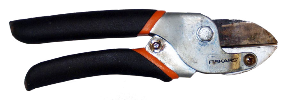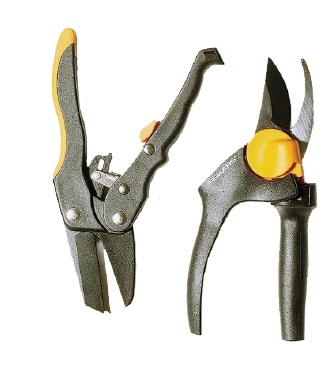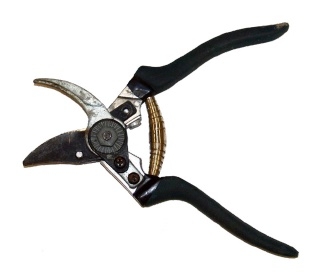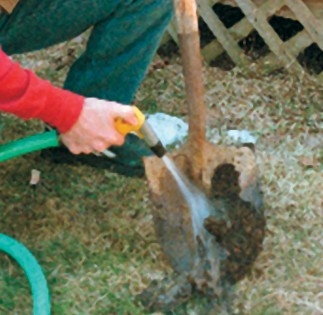Hand Tools Safety: Lawn Care Training Guide Hand Tool Care and Safe Use
ID
BSE-51P (BSE-323P)
Many hand tools such as rakes, shovels, and pruners are used widely in lawn care operations. While these non-powered tools are not known to cause major injuries, they have the potential for injuries that may require absence from work and/or medical assistance when they are used improperly. Examples of such injuries may include bruises, cuts, sprains, back problems, and carpal tunnel syndrome.
The U.S. Bureau of Labor Statistics reported approximately 205,000 wrist, hand, and finger injuries that required an absence from work. The rate of these injuries in all private industries is approximately 29.6 incidences per 10,000 full-time workers. Similar information published by the U.S. Consumer Product Safety Commission shows more than 28,000 cases nationwide receiving hospital treatment for injuries sustained from the use of hand tools.
A large majority of these injuries can be avoided with proper selection and maintenance of tools and careful use. The overall goal of this training guide is to familiarize users with different hand tools used in lawn care and how to use them safely to minimize the number of injuries.
General Safety Rules for Hand Tool Use
- Select the right tool for the job.
- Select tools to match the strength and size of the user.
- Maintain and store the tools properly (sharpening the blade periodically, oil coating to prevent rusting, lubricating, and replacing broken or worn out parts).
- Do not use hand tools under the influence of alcohol or drugs or when fatigued.
- Maintain proper posture when using hand tools. Stretching and twisting the body while working may result in muscle and back problems.
- Use personal protective equipment (PPE) such as goggles, gloves, appropriate clothing, and steel-toed shoes during the use of hand tools to minimize the number of injuries.
Hand Tools
The following sections will provide a general description of hand tools, such as rakes, shovels, and pruners, used in lawn care. Safe practices to minimize the number of injuries specific to each category of tools are listed in each section.
Rakes
While there are many different types of rakes, only lawn and garden rakes are discussed here. Lawn rakes have fanlike, flat, springy teeth. They are designed to glide over the grass and gather grass clippings, leaves, and other debris without damaging the sod. Lawn rakes made of steel, polypropylene, and bamboo are available. While polypropylene and bamboo rake tines have the advantage of being rust-free, the wire holding the tines together has the potential to rust if it is not stored properly or coated with oil. Lawn rakes work most effectively when they are used like a broom. A sweeping motion works better than a raking action.

Types of Rakes
Steel-tine rakes have flat tines. The tines on a good steel lawn rake are made of spring steel, and they have the ability to snap back into position even when they are severely bent during use. When they remain bent, they can be straightened with the help of a pair of pliers. However, due to weakening, there is a strong likelihood that the straightened point may bend again. Because steel rakes have the potential to rust, they should be coated with oil before a long period of storage.
Polypropylene rakes do not rust like metal rakes. They also do not become brittle and break like bamboo rakes. In order to extend the life of this type of rake, it must have strong steel wire reinforcement across the tines and around the area where the head attaches to the handle. This type of rake should be stored indoors to reduce photodecomposition.
Bamboo rakes are lightweight and do not rust. For prolonged life, good reinforcement across the tines and around the area where the head is attached to the handle is essential. The bamboo can be weakened due to weathering, so the rakes must be kept out of the sun and rain when not in use. Avoiding exposure to sun and rain will also help prevent the reinforcement from rusting.
Garden rakes are quite different from the lawn rakes. They come with a long handle and a head with a set of equally spaced steel tines approximately 3 inches long. Unlike the rakes already discussed, the garden rakes have fewer tines. These short and sturdy tines point downward and they lack the capacity to spring back. The spacing between the tines is larger than that of the lawn rakes. Garden rakes are generally used in loose soil for leveling and preparing a smooth seedbed and for incorporating nutrients and lime. Because they are primarily used for moving and spreading soil, garden rakes are made of steel and they are considerably sturdier than lawn rakes. For this reason, during off-season, they should be treated and stored appropriately to prevent rust.
Safe Use of Rakes
Select the right size rake for the job. Choose a rake that is light and easy to use, matching the size and strength of the user.
Do not reach too far out and extend the back during raking. Use shorter raking strokes by standing in an upright position.
Regardless of whether the user is left- or right- handed, continuous raking may overstress the same set of muscles. Periodic breaks or shifting of hand positions may help to minimize this overstressing.
Make sure that rakes left on the ground are facing down.
Secure rakes during transport to avoid injuries.

Shovels, Spades, and Forks
Shovels, spades, and forks are widely used for such lawn care applications as digging and moving soil, edging, splitting plants, and transplanting. These come with long and straight handles or with short handles with D-shape grips. A shovel with a longer handle (40 to 48 inches) will allow the worker to dig deeper holes without significant bending and to throw soil farther when necessary. Long handles also provide better leverage when digging large holes. Shovels with shorter handles (26 to 30 inches) are ideally suited for more precise work that requires better control. They are also good for digging trenches and for use in areas with limited space.
Shovels, spades, and forks generally come with wood, fiberglass, or tubular steel handles. Wood handles are less expensive, and they work well for many years if they are stored indoors. The fiberglass handles are lighter and stronger, and they last longer because they are weather-resistant. Handles made of rolled (tubular) steel also have longer life. They are heavier and more expensive compared to the other two types, but they are ideal for construction-related uses.
Types of Shovels, Spades, and Forks
The cutting edge of shovels, spades, and forks comes in different sizes and shapes to match their use. The blade of the shovel can be pointed, rounded, or square.
- Pointed shovels are used primarily for digging. The tip is pointed to cut through roots or hard soil, like heavy clay.
- Square-nosed shovels are used for moving loose soil or lightweight materials, such as mulch or compost.
- A rounded blade with a slight point is a general-purpose shovel, and it is usually used for digging and lifting.
A general-purpose garden shovel is about 8 to 9 inches wide. Wider blades will have higher capacity, but they require more strength, particularly during continuous use. If the user is not physically strong, a 6-inch-wide shovel will be ideal.
A garden spade with a flat, sharp edge works well for uses such as cutting out sod, breaking apart crowded rootstocks, and smoothing off the sides of a trench. A trenching spade works exceptionally well for digging narrow trenches for underground sprinkler or drainage lines. The blade width varies only slightly in spades.
Although not technically a shovel, a spading fork with its wide, flat tines works well for breaking up hard clay or lifting and moving clumps of bulbs or shrubs. Most garden forks have heads of different sizes with four tines. Heavy-duty forks come with tines with a square cross section, and all the others will have a triangular cross section. Select the fork size based on the strength of the user.
The angle between the blade and the handle (also known as the “cant”) determines the purpose for which a particular shovel is used. For example, the shovel with minimum angle works better for digging holes than for scooping up loose earth; the worker has to bend over uncomfortably to bring the blade of a straight shovel parallel to the ground. A shovel with high cant provides better leverage for prying up heavy soil and similar items. However, it is not suited for digging straight down because the handle has to be farther away from the user to bring the blade perpendicular to the ground.
Shovel Maintenance
Proper maintenance and storage are critical for making effective use of these tools. Shovels and spades must be kept sharp. A dull shovel tip is like a dull knife; it will not easily penetrate into the soil. This is particularly true in compacted soils and heavy clays. After every use, the blade surface should be cleaned with a wire brush or coarse steel wool. Shovels should always be stored in a dry location. Treating wood handles with linseed oil and treating blades with oil to prevent rust is highly recommended before storing for extended periods.
Small Shovels (Trowels)
A trowel is considered to be an essential tool in landscape operations. This tool is used for digging small holes, for bedding plant or bulb installation, or for digging up dead plants or weeds. It works best in loose soil.
Safe Use of Shovels, Spades, and Forks
- Choose the right size shovel for the job, taking into consideration the physical strength of the user.
- Make sure the shovels have sharp edges.
- Make sure the area being dug is free of utility lines. Call Before You Dig: call 811 in Virginia or 1-800- 552-7001 (http://va811.com/).
- Maintain proper posture during shoveling. With feet placed apart, maintain balance and a solid footing.
- Avoid twisting the body during shoveling.
- Do not throw material in the air. Instead, let the material slide off the shovel blade.
- Secure shovels, spades, and forks in a vehicle during transport to avoid injuries.
Pruning Devices
Trees and shrubs are pruned annually to keep them healthy and attractive. Pruning is also done to remove diseased and/or dead limbs or stems. Limited pruning can be done with flower shears. Large branches or woody stems require large pruners or loppers. Pruning is hard work, and it involves repetitive motion; for this reason, selecting the right tool for the job on hand is extremely important. Factors such as the purpose of pruning, types of pruners available, when the pruning is to be done (summer or fall), and types of plant material to be pruned must be considered before selecting the pruner. Smaller jobs such as pruning flower bushes and thin branches can easily be carried out with hand pruners. Loppers and saws are needed for cutting through thick tree limbs and branches.
Types of Pruners
The three types of pruners commonly used are anvil, ratchet, and bypass.



The classification is strictly based on the type of blades.
- Anvil pruners feature a single straight blade that uses a splitting action to cut a stem or branch. This type of pruner is good for cutting dry branches and stems.
- Ratchet pruners are similar to anvil pruners except they have a mechanism that allows cutting in stages. Ratchet pruners are ideal for those with limited strength.
- A bypass pruner cuts like scissors and is the most popular type. Two curved blades of a bypass pruner make a nice, clean cut. This type of pruner works well on actively growing stems.
Table 1 shows the conditions under which the different pruning tools can be used for best results.
| Pruning Tool | Best Used For |
|---|---|
| Anvil pruner | Use for: dead twigs and branches Diameter: 5/8” or less Ex: rose bushes, hydrangea |
| Bypass pruner | Use for: live stems and branches Diameter: 5/8” or less Ex: rose bushes, raspberry bushes |
| Hedge shears | Use for: hedges, small shrubs, evergreens Diameter: 2 1/4” or less Ex: any kind of hedge shrub |
| Lopper | Use for: medium-large branches Diameter: 2 1/2” or less Ex: fruit and nut trees |
| Pole pruner | Use for: dead wood on trees Diameter: 1 1/4” or less Ex: any tree |
| Tree pruner | Use for: smaller tree branches Diameter: 1 1/4” or less Ex: any tree |
Safe Use of Pruners
Workers should be aware of the potential hazards associated with pruning operations. By taking small precautionary steps, it is easy to avoid injuries. Before pruning, workers should receive training in pruning hazards, safe pruning techniques, safe tool handling, ladder safety, and use of PPEs. The following are the safety tips to avoid pruning injuries.
Select the right type of pruner for the job.
Make sure the pruners are in good working condition and the blades are sharp.
Use PPEs to protect from injuries. Use of eyewear, eye protection, long-sleeved shirts and long pants to avoid cuts, and hard hats and steel-toed shoes to protect against falling limbs and debris are recommended.
Pruners often work at heights, and they should be trained on ladder safety, including proper climbing, ladder placement, and ladder maintenance.
Ensure that pole pruners do not come in contact with power or utility lines.
Use proper lifting techniques by avoiding awkward postures.
Do not reach out too far during pruning in order to avoid muscle pulls and/or falls.
- Do not prune under the influence of alcohol or drugs.
Pruner Maintenance
Many injuries can be avoided with proper maintenance and storage of pruning tools. Dull, sticky tools may cause slipping, which, in turn, can lead to cuts and other injuries. After each day’s work, wipe the blade clean with a dry cloth and lubricate the movable handle shaft and spring. Sharpen blades whenever extra effort is needed to make the cut. Adjust the blade or replace worn out parts when the cut is not clean.
Cleanup
Like all other jobs, yard work also ends with cleanup. This involves cleaning the surrounding work area, cleaning the tools, and storing them properly. While equipment such as blowers are more popular, brooms, brushes, rakes, and hoses are also used widely for cleaning work areas and tools. Rakes are used to gather grass clippings, leaves, and other debris and collect them into trash bags or tarps for proper disposal and/ or composting. Brooms, brushes, and water hoses are used to clean the walkways, driveways, and sidewalks.
At the end of each workday, all tools used should be cleaned and stored properly in a dry place. While cleaning, it is also a good practice to examine tools for broken, loose, or worn out parts and repair them prior to storing. Tools that need maintenance should be labeled and left in the designated location for appropriate action.

Safety Tips
Use of PPEs, such as safety glasses, sturdy work gloves, and heavy footwear, is recommended during cleaning. Rubber or latex gloves should be used when washing tools. While cleaning sidewalks and streets, take steps to protect both workers and passers-by. When working on the roadside, appropriate signs must be posted to alert drivers of motor vehicles to slow down. It is also a good practice to schedule such operations during a time when the traffic is light. Workers working in teams of two and wearing reflective stripes may also help to reduce accidents.
When lawn care workers work near sidewalks, they should watch for pedestrians. Allow adequate time for them to pass by without rushing them. Special attention should also be directed toward protecting children and pets in the area close to the operation.
Cleanup invariably involves lifting bags filled with grass clippings and other debris from the yard. Workers should wear a back brace and use proper lifting posture to protect their backs when lifting loads.

Hand Tool Care, Maintenance, and Storage
Properly maintained tools help improve efficiency of operation while minimizing opportunities for injuries and extending tool life. Time spent in tool maintenance (sharpening, cleaning, lubrication, etc.) is time well-spent.
Prior to use, always inspect the tools for defects or damage. Check for loose, bent, or cracked tool handles, mushroomed tool heads, sprung tool joints, or worn teeth. If a hand tool fails the initial inspection, inform the crew leader, tag the tool clearly as “defective,” and remove it from service.
Allow adequate time at the end of each workday to clean the tools and properly pack and secure them for transportation or storage. Maintaining a safe and efficient work environment will help avoid injuries and unnecessary expenditures in the long run.
Maintenance
- Keep metal blades of all tools sharp and well-oiled.
- Check regularly for loose and worn out parts on tools and replace them if necessary.
- Lightly sand and clean wooden parts regularly and treat them with a 50/50 mixture of linseed oil and turpentine.
- Identify damaged tools and store them in a designated location to allow either the supervisor or maintenance person to arrange for their repair.
Workers should know that the job is not complete until the tools are cleaned and stored in a designated location.
Cleaning
- Clean the tools immediately after use.
- Wash the tools using water. A wire brush may be useful to loosen the soil stuck to the blades.
- Minimize the risk of spreading germs while dirty tools are being cleaned.
- Coat the blades with light oil like WD-40 on areas prone to rust.

Storage
Store tools in a dry, sheltered environment.
Place tools on a rack for safety and easy access.
Place similar tools close together so workers can easily see the available tools.

Resources
California Occupational Safety and Health Administration and the National Institute for Occupational Safety and Health. (NIOSH). Easy Ergonomics: A Guide to Selecting Non-Powered Hand Tools. DHHS (NIOSH) Publication No. 2004-164. Cincinnati, OH: NIOSH. https://www.cdc.gov/niosh/docs/2004-164/pdfs/2004-164.pdf.
Tailgate Safety Training for Landscaping and Horticultural Services: Equipment and Plant Transport. Ohio State University Extension, Agricultural Safety Program. Publication No. AEX 192-07.
University of California. “Safe Use of Rakes and Shovels.” Safety Note No. 96. Agriculture and Natural Resources, Environmental Health and Safety. http://safety.ucanr.org/files/66218.pdf.
Training Videos
Safety Makes Sense – www.ugaurbanag.com/safety
Online video series from the University of Georgia Center for Urban Agriculture. OSHA-approved (in English and Spanish), five-video series includes topics like lawn mower and equipment safety, appropriate clothing, sun protection, heat stress, and heat stroke.
www.youtube.com/user/ugaurbanag
Acknowledgements
This publication was developed with the support of the National Youth Farm Safety Education and Certification Program (Grant No. USDA/NIFA-2010-41521-20830), the National Institute of Food and Agriculture, and the U.S. Department of Agriculture. The team that developed this publication is solely responsible for its content, and it does not necessarily reflect the views of the USDA or the U.S. Department of Labor. The team members are Robert Grisso, John Perumpral, Don Ohanehi, Mike Goatley, Kathleen Jamison, Cathy Sutphin, Dan Swafford, and Carl Estes.
The authors are grateful to the following for permission to use their pictures: J. Dan Swafford, The Taunton Press Inc./Fine Gardening, Marc Moran, Lisa Shin, commons.wikimedia.org, and Instructables. Wikimedia and Instructables have Creative Commons licenses: https://commons.wikimedia.org/wiki/File:Fan-shaped_leaf_rake.jpg.
Virginia Cooperative Extension materials are available for public use, reprint, or citation without further permission, provided the use includes credit to the author and to Virginia Cooperative Extension, Virginia Tech, and Virginia State University.
Virginia Cooperative Extension is a partnership of Virginia Tech, Virginia State University, the U.S. Department of Agriculture, and local governments. Its programs and employment are open to all, regardless of age, color, disability, sex (including pregnancy), gender, gender identity, gender expression, national origin, political affiliation, race, religion, sexual orientation, genetic information, military status, or any other basis protected by law
Publication Date
January 29, 2024



